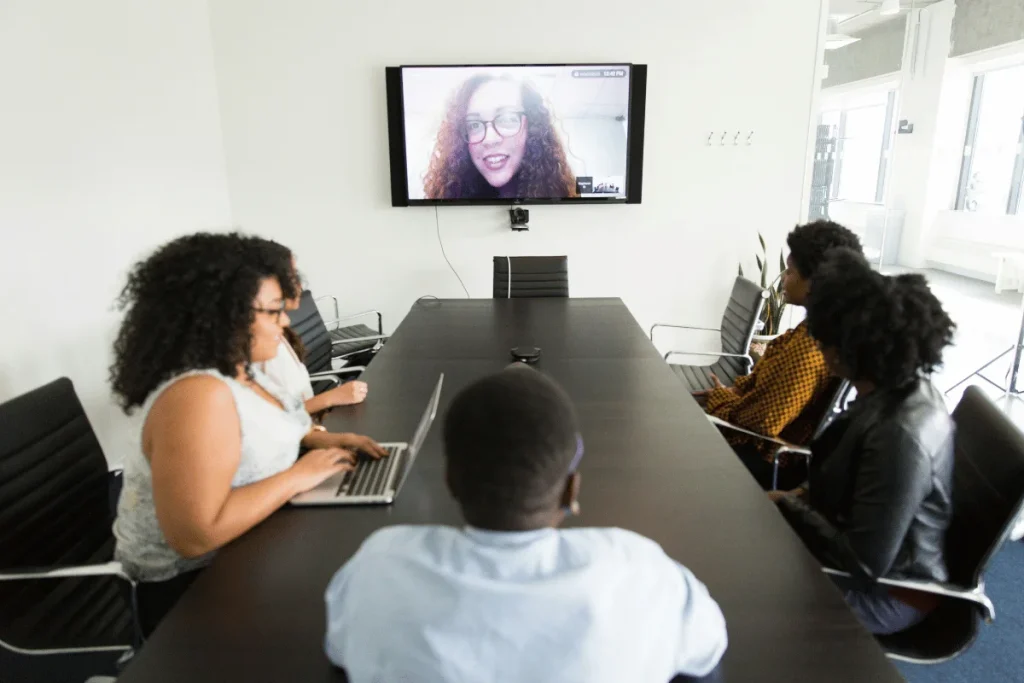Are you a business or executive coach looking to start a mastermind group?
A recent survey reported that about 98% of members found mastermind groups to be ‘valuable’ or ‘extremely valuable.’
Unfortunately, many founders lack the requisite skills to run successful mastermind groups.
This article provides an in-depth overview of how to run a mastermind group, including common mistakes and best practices.
Wondering how to deliver value to your mastermind group?
Use Hello Audio private podcasts to share exclusive content with group members and create a sense of community. You can also distribute the content to platforms like Spotify and Apple to enhance accessibility and allow members to consume the content on the go.
Sign up for Hello Audio with our 7-day free trial!

What is a Mastermind Group?
The simplest definition of a mastermind group is a gathering of people with similar or shared interests and goals. The group meets frequently to support and encourage each other towards achieving pre-determined goals.
Contrary to popular belief, mastermind groups must not necessarily comprise people in the same profession. However, the groups are often effective when the members are at the same level, such as entrepreneurs or senior-level managers.
Core Elements of a Mastermind Group
Looking to start a mastermind group? Ensure the group has the following key features:
- Shared Goals or Purpose: The selected members must share a common purpose to help keep the group focused. The goals could cut across professional and personal milestones.
- Commitment: All members should diligently attend meetings and participate in activities.
- Diversity: The group should comprise people of different demographics, professions, and backgrounds to foster a robust exchange of ideas.
- Trust and Confidentiality: Mastermind groups are built on mutual trust. Members should not disclose each other’s information to third parties or expose the group’s activities to outsiders.
- Effective Facilitation: The group should appoint or elect stewards to facilitate meetings.
- Accountability: Members should make regular check-ins and provide progress reports to hold each other accountable.

Benefits of Running a Mastermind Group
Here are the main incentives for running a mastermind group:
Leadership Skills
Running a mastermind group develops your leadership skills, including facilitating discussions or moderating conflicts. You also become the group’s anchor, directing and inspiring members to remain ‘committed to the cause.’
Over time, you can implement your leadership skills in other group settings, including organizational contexts.
High-Value Feedback
Mastermind groups run on members’ collective intelligence. You can present your ideas and receive immediate feedback.
This creates a feedback loop that helps refine your strategy or solve persistent issues.
Networking Opportunities
Each member adds their network to the group, creating an expansive ecosystem of connections.
This opens new doors for members to network and collaborate with people who would otherwise be out of their reach.
It also creates collaborative opportunities, increasing the overall value of the group.
Renewed Focus
Mastermind groups provide a controlled/structured environment for tracking personal and professional milestones.
Members hold each other accountable for renewed focus and drive.
Personal Development
Dynamic mastermind groups offer invaluable growth opportunities professionally and personally. You can benefit from diverse viewpoints, expanding your perspective and evolving your mindset.
It also encourages introspection to identify self-limiting factors and ways to address them to foster personal growth.
Sense of Community
A mastermind group gives members a sense of belonging. Members can connect with people with similar interests and aspirations.
It also creates a safe space for sharing personal challenges and achievements.

How to Run a Mastermind Group
Below is a step-by-step guide for running a successful mastermind group:
1. Define the Group’s Objective
Outline the mission, vision, and goals to provide a framework for running the group. This helps keep the group activities focused on achieving the desired outcomes.
Clear objectives also help attract the right members based on how their goals align with the group’s.
2. Pick the Right Members
Invite individuals with shared interests and goals for compatibility reasons.
However, prioritize members with diverse attributes to make the group dynamic.
3. Establish Ground Rules
Set clear guidelines for participation and engagement within the group. You could also outline a code of conduct highlighting the standards members must uphold.
This helps enforce respect and confidentiality, providing a safe environment for all members.
4. Create a Meeting Schedule
Determine how often the mastermind group should meet, depending on the set goals. Regular meetings facilitate quick problem-solving and accountability among members.
The meeting schedule should be convenient for all members.
Pro tip: Incorporate virtual meetings to ensure high attendance.
5. Structure Your Meeting Agenda
Prepare a clear agenda to keep the meetings productive and focused on the group goals. The agenda should include the following core elements:
- Progress updates based on previous meetings.
- Open floor sessions where members can share their challenges.
- Brainstorming sessions with timebound action items.
6. Facilitate the Meetings
Play your role as the group leader to foster participation from all members. Leverage strategies like active listening and follow-up questions to show members you are attentive and value their contributions.
Additionally, highlight success stories to set an uplifting mood and motivate members to remain focused on their goals.
7. Evaluate and Adapt
Collect members’ feedback about the group, including what they like or dislike and ways to address the issues. You could ask members to evaluate their progress and outline the support they require to achieve their goals.
Use the gathered feedback to restructure the group’s strategy and agenda to align with members’ goals.
Ready to build a mastermind group and grow it into a community of like-minded members? Use Hello Audio!
Our platform lets you invite people to your community, where they can access exclusive content to keep them engaged.
Book an instant demo for a hands-on experience of what Hello Audio can do for your mastermind group.

Common Challenges in Running a Mastermind Group
Below are common obstacles you might encounter when running a mastermind group:
Unclear Goals
Undefined or unclear goals are arguably the most significant cause of failure among mastermind groups.
Some members may struggle to align their personal goals with the group’s objectives, causing the group to lose focus. It also becomes difficult to measure performance and track progress.
Have clear goals and objectives to ensure members manage their expectations and understand their roles.
Poor Facilitation
Avoid micromanaging the group. Your role as a leader is to facilitate the group, not dominate the members.
The latter often causes members to disengage from the discussions.
For virtual meetings, utilize online community moderation strategies to foster engagement.
Colliding Interests and Goals
Conflicting interests between members or personal goals and group objectives can cause tension. This hinders collaboration as members tend to compete among themselves.
Pick members with shared interests and aspirations to foster collaboration.
Members Are Not Committed
Issues like chronic absenteeism undermine the group’s effectiveness. For example, some pertinent issues are often postponed because the quorum is not met.
Leverage strategies like celebrating milestones to keep members motivated. You could also set clear guidelines for the members’ expected attendance rate.
Poor Conflict Resolution
Unresolved conflicts create tension in the group, disrupting progress. You also risk diminishing group morale and culture in the long term.
Establish clear conflict resolution frameworks and uphold fairness to preserve the group’s unity.
Lack of Accountability
Not tracking progress results in stalled tasks and unmet goals. It also results in members not following through on their commitments.
Establish accountability mechanisms, including regular check-ins and task logs to track progress.
Communication Breakdown
Poor communication affects group efficiency, as members spend much time addressing issues that would otherwise be resolved quickly.
Facilitate effective communication during meetings to encourage participation by all members.
Some proven methods of facilitating communication during meetings include:
- Ask open questions to solicit members’ feedback.
- Listen actively to show others their responses are valued.
- Leverage non-verbal cues like nodding to encourage members to share their thoughts.
- Ensure everyone has a chance to speak to boost engagement.

Best Practices for Running a Successful Mastermind Group
Use these proven tips to run a successful mastermind group:
- Pick Compatible Members: Invite members with common interests and similar levels of ambitions. Also, select members with complementary skills to foster collaboration.
- Meet Regularly: Schedule bi-weekly or monthly meetings depending on members’ availability and task intensity. Keep the meetings brief and focused on the day’s agenda.
- Keep Records: Archive your meeting notes for easy reference in the future. For example, you can repurpose meeting recordings into private podcasts and share them with members.
- Encourage Participation: Request members to attend group activities. Also, encourage them to celebrate their milestones in the group setting.
- Set Clear Ground Rules: Outline guidelines on attendance, participation, confidentiality, and conflict resolution. Ensure members understand the ground rules, including the group’s code of conduct.
- Ensure Accountability: Establish a supportive culture where members provide updates on their progress.
- Communicate Effectively: Facilitate open dialogue and encourage members to express their thoughts or feedback on outstanding issues.
- Build a Community: Learn how to build an online community and encourage members to interact beyond the scheduled meetings. This includes attending social gatherings or networking for collaboration opportunities.
- Leverage Technology: Check whether you can incorporate various technologies to streamline the group’s organization. For instance, you can introduce project management tools to track tasks.
Finding value in these tips? Explore more:

Frequently Asked Questions (FAQs)
Let’s answer popular questions about running mastermind groups:
How Do I Recruit Members for My Mastermind Group?
The best way to recruit individuals to your mastermind group is by defining the ideal member persona.
Next, identify people you think meet the criterion and invite them to the meeting. You can source members from various platforms, including LinkedIn, Facebook groups, professional associations, or your existing network. For a smoother process, refer to our virtual event checklist to ensure you don’t miss any essential steps.
What’s the Ideal Size for a Mastermind Group?
We recommend limiting your mastermind group to between five and 10 people.
This ensures the group is vast enough to accommodate diverse attributes without compromising on the quality of interactions.
What Tools Are Recommended for Managing a Mastermind Group?
Below are recommended tools for running a mastermind group:
- Communication tools like Zoom
- Scheduling tool or shared calendar
- Collaboration tool with shared workspaces
- Feedback collection tool
- Online community platforms like Hello Audio
Conclusion
As the group leader and facilitator, your input significantly influences the mastermind group’s success. With this in mind, you must build team spirit among members.
However, the biggest challenge to running a successful mastermind group is keeping your members motivated, especially if you do not meet regularly.
Our platform – Hello Audio – lets you share exclusive content as private podcasts that members can consume on the go. Even better, you can convert previous meeting recordings into private podcasts and share them with those who couldn’t attend the session.
Sign up for our 7-day free trial today and unlock Hello Audio’s premium features!












